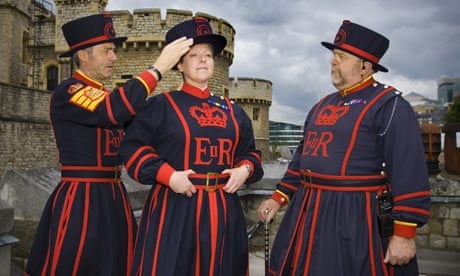Arrive at the Tower of London today, and a smiling Beefeater will guide you knowledgeably through centuries of grisly history. It wasn't always the way. If you'd fetched up as an 18th-century tourist, you'd have been well advised to hold your purse tight and watch out for your womenfolk, as the Beefeaters of yore, it seems, had earned themselves a rather unsavoury reputation.
Dr Janette Martin, of the University of Huddersfield's Centre for Oral History Research and The Arms and Armour Research Group, has recently completed a research project into the evolution of the role of Yeoman Warder of the Tower of London and an analysis of their place in the British identity.
Martin explains that, rather than being lauded as a national asset, for many years the Tower guards were infamous as a shocking bunch of scoundrels in urgent need of reform. Extortion was common, with hapless sightseers their usual prey.
As far back as 1598, she discovered, Sir John Peyton, Lieutenant of the Tower, complained that many warders were "unfitt for the place; some of them utterly neglectinge their duties in service, others given to drunckeness, disorders and quarrells".
It seems, says Martin, that the dissolution continued apace.
"John Bayley claimed in his History of the Tower of London that the warders were a disgrace," she says.
"Rather than guarding the Tower, he wrote, 'they have gradually assumed to themselves the more lucrative occupation of stopping every body who wishes to visit these objects of our national pride and glory and forcing themselves upon them as their guides...'"
Fortunately for today's tourists, once the Duke of Wellington stepped in as the Tower's new Constable in 1826, he whipped the warders into shape pretty smartish. This involved sacking the worst incumbents and abolishing the practice of Beefeaters selling on their position to anyone who had a spare 250 guineas.
The role is now restricted to those who can boast 22 years of military service, have reached at least the position of Warrant Officer and been awarded a good conduct medal. The post is salaried, and today's Beefeaters – the origin of the name is uncertain – are employed by the independent charity Historic Royal Palaces.
Though Martin doubts that democratising the role was at the forefront of Wellington's mind, the effect of his reforms, she says, resulted in "anyone, however low their origins, through long and exemplary service in the army, being able to obtain this prized position at the historic heart of the nation. And this transparency of appointment allowed the warder to become a popular symbol transcending class and region, because the British army attracted recruits from England, Scotland, Ireland and Wales and Yeoman Warders were thus drawn from all parts of the kingdom."
Martin's research has involved not only examination of the Tower's archives, but also recording the stories of working Yeoman Warders in the first oral history project to capture the characters and histories of those who choose to wear the iconic uniform today.
"And make sure you call it a uniform, not a costume," she warns. "They're a bit sensitive about that. And though they live in the Tower, it's not a grace and favour thing, they pay market rent – they'd want me to get that in!"
The Yeoman Warders' hierarchy and traditions reflect that of the military system they're drawn from. Around 40 are employed at any one time, with a Chief Yeoman Warder in overall charge. In a strict hierarchy, four Yeoman Serjeants report to him, with the other Beefeaters, including the famous Raven Master, working under them.
Somewhat unusually for academic research, Martin's interviews were recorded in the Yeoman Warders' drinking club at the Tower, surrounded by bottles of Beefeater Gin. New Yeoman Warders, it seems, take part in a unique welcoming ceremony on Tower Green.
"They're given a special goblet and go back to their club to make the toast 'May you never die a Yeoman Warder'." The sentiment, Martin explains, harks back to the time when the position could be sold on.
The fact that there is still only one female Beefeater is explained by the far smaller pool of women than men who can demonstrate the required 22 years of military service. Though numbers of women in the services are vastly higher now than two decades ago, the time lag before they're eligible to apply means it's likely to be a while before there'll be a large contingent of female Beefeaters welcoming tourists to the Tower.
What, then, draws an ex-serviceperson to a job in which the most frequently asked question is "where's the toilet?"
"When they leave the army," observes Martin, "they're still relatively young. It's security. And after you've had a career going round the world, the world comes to you."
There are odd quirks to being a Yeoman Warder, Martin discovered. Some of their apartments look out over Tower Green, and one Beefeater described in his testimony the strangeness of doing his washing-up looking out over the spot where Anne Boleyn, among other unfortunates, had her head chopped off.
Work doesn't finish when the tourists go home. Part of the job has always been to guard the Tower at night. Martin's delving through the archives revealed that there was a civil service dispute in the 1930s during which the Yeoman Warders went on strike. "However, they felt it was still vital to patrol the Tower at night," she explains, "and so they continued with that part of their job and then donated their pay to charity."
As well as a scholarly article and the creation of an oral history archive, Martin is working on an illustrated book showing how the Beefeaters have comprehensively rehabilitated themselves to become a popular and highly respected icon of Britishness. What goes on in London's oldest private drinking club once the Ceremony of the Keys is over at 10pm, however, the public will never know.

Comments (…)
Sign in or create your Guardian account to join the discussion